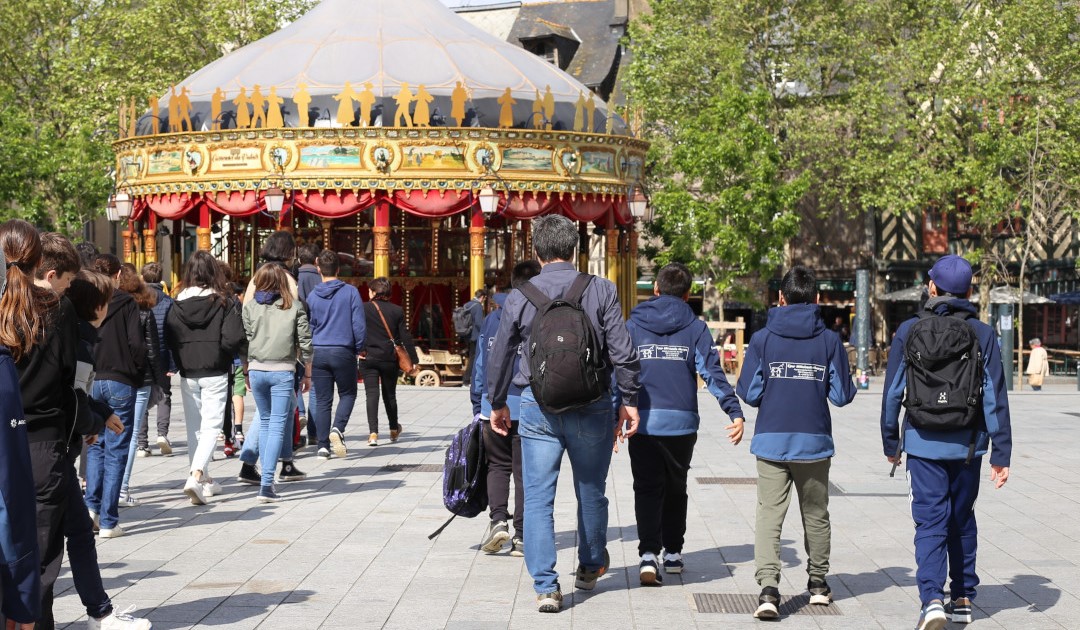
Young Greenlanders accompanied by their English and science teachers visited Rennes, in Brittany, on Friday. The exchange was organised by Greenlandia, an association that maintains almost century-old relations between the hamlet of Ittoqqortoormiit and France
In the corridors of Sciences Po Rennes, five metres in front of the entrance to the meeting room, a Greenlandic boy dances forward, jumping from one foot to the other. He is part of a small Greenlandic delegation that visited the city of Rennes on Friday as part of a cultural exchange organised by Greenlandia, a group that maintains almost century-old relations between the hamlet of Ittoqqortoormiit and France.
The seven 12-year-olds and two of their teachers arrived in France on 3 May for a trip that will bring them to Brittany and Paris. “We weren’t sure we could accommodate them until a few weeks before their departure, as inflation has driven up the the price of plane tickets,” explains Vincent Hilaire, executive director of the Greenlandia expedition, a 10-year project that is facilitating visits by Greenlandic and French young people to each other’s country.
He describes meeting Juulut Danielsen in 2015. The English and mathematics teacher is the former mayor of Ittoqqortoormiit. Mr Hilaire had sailed to Greenland and was welcomed “like a member of the family” by the community that, in 1936, hosted a group of French explorers led by Jean-Baptiste Charcot. “He was very important to our community,” says Mr Danielsen, walking to Rennes. Mr Hilaire, walking alongside him, adds: “Charcot treated these people during an epidemic of tuberculosis and he helped build houses.” The story is one that Mr Danielsen recalls his grandparents telling him.


His term as mayor ended when Ittoqqortoormiit was merged with a number of other councils, but the opinions and the goals he had while in office remain intact. Greenland’s government wants to raise the level of education among its young people so they are up to the challenges their society will face — things like climate change, the establishment of a mining industry and the drive towards independence. If today the eyes of the world are turning towards the North, Mr Danielsen is doing his utmost to ensure that the young people of the hamlet are prepared. This is one of the reasons why he came to France with Greenlandia and why they stopped by Sciences Po Rennes.
During their visit to Sciences Po Rennes — short for Institut d’Etudes Politiques de Rennes — they were welcomed by representatives from the administration, including Nicolas Escach, who spent a few weeks teaching political science at Ilisimatusarfik, Greenland’s university, in Nuuk. Sciences Po Rennes receives and sends students to Greenland’s capital every year. The members of the delegation are just 12, but their trip is part of a relationship that is much bigger.
At the end, when Mr Escach asks the youngsters what they think of France, they answer one after the other: “It’s great, but it’s very hot.” “There are lots of shops. Lots of students. Lots of everything.” “It’s very green.” Their teacher found the size of the oak trees in the park in the centre of Rennes quite impressive.


“Nature is at the centre of their way of life, which is also what is interesting about this cultural exchange. During their time here, they have been completely captivated by the animals,” adds Mr Hilaire. Ittoqqortoormiit was established in 1924, by 12 hunting families in eastern Greenland. “My grandfather was the last to leave the old village for this new place to live,” says Mr Danielsen. It was located at the end of a fjord, rich in game and a lookout point for the Danes.
Students from Collège de Fontenay, a secondary school in Brittany, visited Ittoqqortoormiit in 2022 with the help of Greenlandia. “The villagers took us to the foot of the glaciers with sledge dogs,” recalls Etienne Walger, a member of the association. Plans for that visit began a year earlier when the two classes met for a video conference, in English. The French students wrote a glossary of everyday words in Tunumiit, the language spoken in eastern Greenland. These preparations served as a common thread for the respective classes, bringing together climate, energy and cultural issues. On their return, the French students hosted a dozen events related to their trip in the region.
The trip cost €80,000 and was paid for with funding from the département and Erasmus, the EU educational programme, as well as the families of the participants. The next visit will see Parisian teens visiting Ittoqqortoormiit to refurbish “maison des Français”, a now-derelict building built on the site of Charcot’s station in the hamlet.
Camille Lin, PolarJournal
More about this topic





